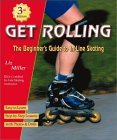Inline Skating: Braking
Braking when inline skating is quite difficult. Whilst skating itself is easy to learn, most people have serious problems trying to brake.
The only problem with inline skating is the numerous injuries caused by falling which usually happen as a result of carelessness and mostly because many skaters do not know how to brake. For this reason it is important to spend a lot of time learning the various braking techniques. At least one break technique needs to be mastered.
top 

Get Rolling, the Beginner's Guide to In-line Skating, Third Edition

Inline!: A Manual for Beginning to Intermediate Inline Skating
|
Braking with Inline Skates:
1. The Heel Stop
The heel stop is a very effective braking technique. Stopping with the brake on the inline skate probably does not look very cool but it is very effective. When doing the heel stop, bend your knees and extend the foot with the brake forwards. Place the weight on the back leg and carefully lift the tip of the front inline skate. This pushes the brake into the tarmac and stops the motion.
2. The “Grass” Stop
The “grass” stop is an effective but not very elegant brake technique. In emergencies, swerving onto the grass (which is hopefully available) is a rather safe technique which most beginners often forget. It is important not to put any weight on the front wheels but to completely shift it to the heels. One of the skates should be placed in front.
3. T-Stop
To do the T-stop, place one skate behind you at 90° to your direction of travel with all of the wheels dragging on the ground at the same time. Put all your weight on the front leg. The T-stop causes the wheels to wear out very quickly. The stopping distance is almost twice as long as the heel stop.
4.) The “Tree” Stop
Be careful! Tress and street lights should only be used for braking when skating at a low speed. If you are skating at a higher speed, this braking technique can lead to serious injuries. Beginners in particular underestimate their speed when they use, for e.g., street lights to help them stop.
5.) Power slide
The power slide is only for advanced skaters. The power slide is absolutely ideal for breaking when skating at high speeds. Using the power slide to brake involves flipping backwards. Look ahead of you and place the leg you want to use to brake against the direction of travel. As you are doing this, drag the wheels on the ground. The power slide is a very challenging braking technique but it is also extremely effective. The wheels get worn out very quickly.
top  |

